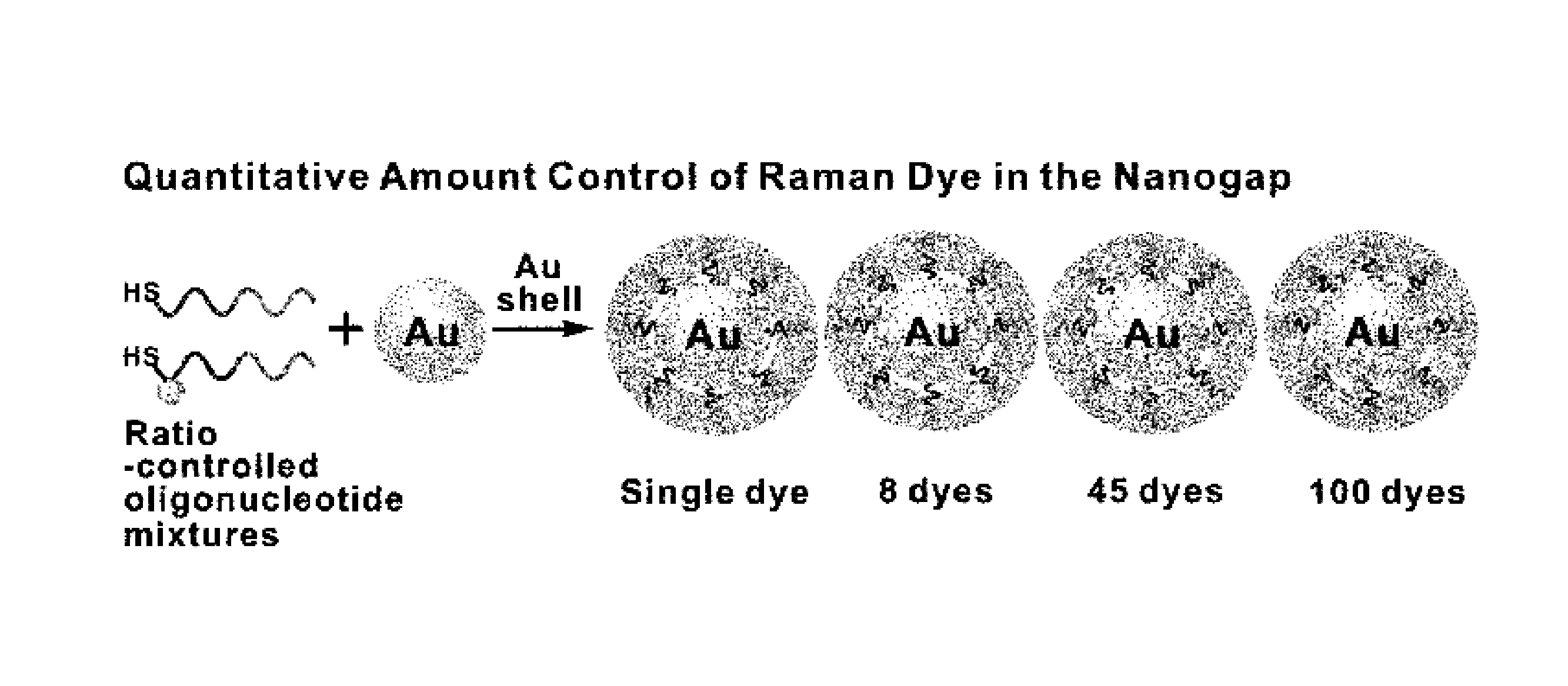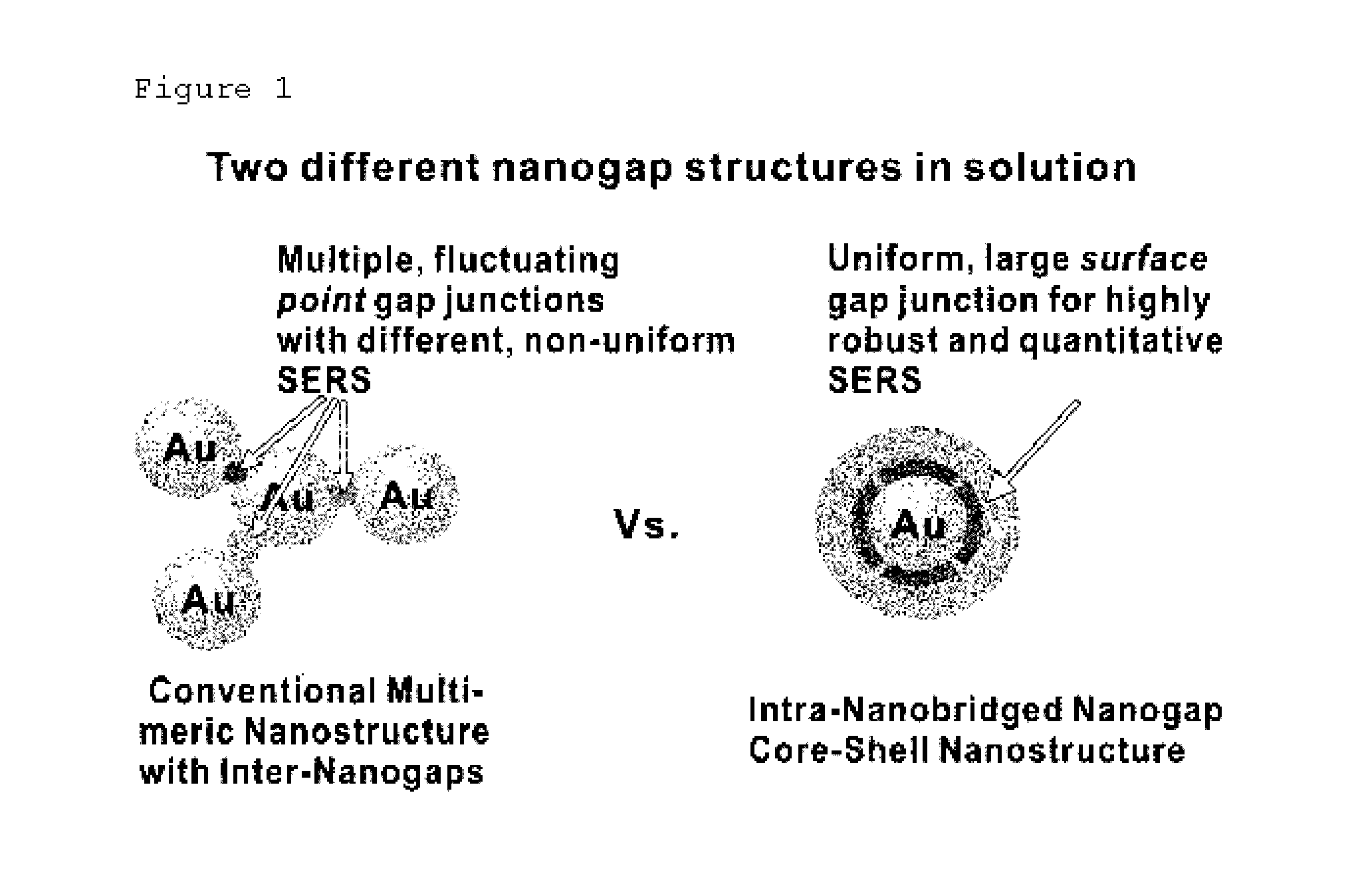Single nanoparticle having a nanogap between a core material and a shell material, and preparation method thereof
a nanoparticle and core material technology, applied in the field of single nanoparticles, can solve the problems of fluorescent dyes, inconvenient long-term storage or experiment, difficult handling, etc., and achieve the effects of high reproducibility, uniform thickness, and large surface area
- Summary
- Abstract
- Description
- Claims
- Application Information
AI Technical Summary
Benefits of technology
Problems solved by technology
Method used
Image
Examples
example 2
Fem Calculation of Gold Nanoparticle and Core-Shell Particle Surrounded by Nanogap without Bridge and Silica
[0103]In order to understand relation between Au—NNP and electromagnetic wave, FEM (3D finite-element-method was applied to the calculation (Wustholz, K. L. et al. Structure-activity relationships in gold nanoparticle dimers and trimers for surface-enhanced Raman spectroscopy. J. Am. Chem. Soc. 132, 10903-10910 (2010)), and the results were compared with Au—Au core-shell nanoparticle surrounded by silica (FIG. 9). In every calculation, four intra-nanobridges were assumed to be formed between Au core and Au shell. Radius of core is 20 nm, nanobridge is cylindrical shape of 2.5 nm×1.2 nm, size of gap or thickness of silica is 1.2 nm, and thickness of shell is 11 nm. Linearly polarized plane wave incident along the x-axis was used for plasmon excitation. The intensity of EM enhancement is represented in FIG. 9a, which indicates that EM enhancement is located intensively on the in...
example 3
Preparation of Nanoparticle with Modified Location of Raman Dye
[0104]DNA strand was used for forming platform for Raman dye modification as well as forming intra-nanogap.
[0105]Three different kinds of reduced thiolated oligonucleotides with modified location of dye (ROXgap (760 μL, 4.3 μM): 3′-HS—(CH2)3-(ROX)-A10-PEG18-AAACTCTTTGCGCAC-5′(i.e., 3′-HS—(CH2)3-(ROX)-SEQ ID No.1-PEG18-SEQ ID No.2-5′), ROXshell (131 μL, 24.9 μM): 3′-HS—(CH2)3-A10-PEG18-(ROX)-AAACTCTTTGCGCAC-5′ (i.e., 3′-HS—(CH2)3-SEQ ID No.1-PEG18-(ROX)-SEQ ID No.2-5′) and ROXouter (456 μL, 7.1 μM), 3′-HS—(CH2)3-A10-PEG18-AAACTCTTTGCGCAC-(ROX)-5′ (i.e., 3′-HS—(CH2)3-SEQ ID No.1-PEG18-SEQ ID No.2-(ROX)-5′)) was mixed with and reacted to citrate-gold nanoparticles (1 ml, 1.0 nM) for 20 minutes at room temperature, respectively. In order to obtain as final phosphate concentration of 10 mM (pH 7.4), the resultant solution was adjusted with 100 mM phosphate buffer (for ROXgap, ROXshell and ROXouter, 176 μL, 113 μL and 146 μL a...
example 4
Preparation of Nanoparticle with Adjusted Amount of Dye
[0111]The number of Raman dyes in the intra-nanogap was adjusted as follows, characteristics were identified accordingly and the whole process was schematically shown in FIG. 11a.
[0112]It is known that if poly A spacer is used in the condition of 0.3 M PBS, the number of oligonucleotide loading on 20 nm gold nanoparticle can be approximately 100 according to the size of nanoparticle and DNA loading characteristic of DNA spacer (S. J. Hurst, A. K. R. Lytton-Jean, C. A. Mirkin, Anal. Chem. 78, 8313 (2006)). Hereupon, the mixtures of surface protecting sequence and ROXgap-modified sequence (surface protecting sequence: 3′-HS—(CH2)3-A10-PEG18-AAACTCTTTGCGCAC-5′ (i.e., 3′-HS—(CH2)3-SEQ ID No.1-PEG18-SEQ ID No.2-5′), ROXgap-modified sequence: 3′-HS—(CH2)3-(ROX)-A10-PEG18-AAACTCTTTGCGCAC-5′) (i.e., 3′-HS—(CH2)3-(ROX)-SEQ ID No.1-PEG18-SEQ ID No.2-5′) of four different kinds of ratio (99:1 (259 μL, 12.6 μM: 2.4 μL, 13.8 μM), 90:10 (235...
PUM
| Property | Measurement | Unit |
|---|---|---|
| diameter | aaaaa | aaaaa |
| thickness | aaaaa | aaaaa |
| diameter | aaaaa | aaaaa |
Abstract
Description
Claims
Application Information
 Login to View More
Login to View More - R&D
- Intellectual Property
- Life Sciences
- Materials
- Tech Scout
- Unparalleled Data Quality
- Higher Quality Content
- 60% Fewer Hallucinations
Browse by: Latest US Patents, China's latest patents, Technical Efficacy Thesaurus, Application Domain, Technology Topic, Popular Technical Reports.
© 2025 PatSnap. All rights reserved.Legal|Privacy policy|Modern Slavery Act Transparency Statement|Sitemap|About US| Contact US: help@patsnap.com



